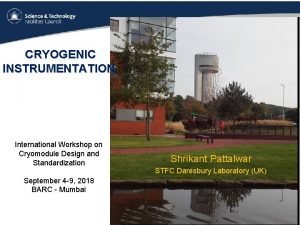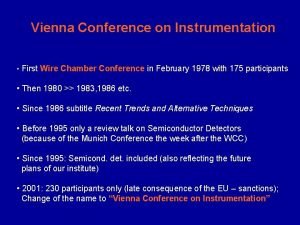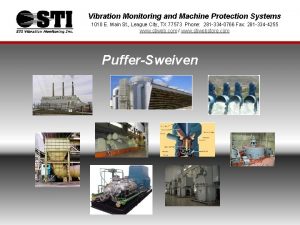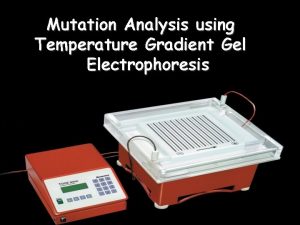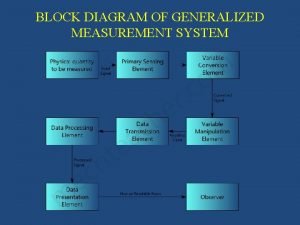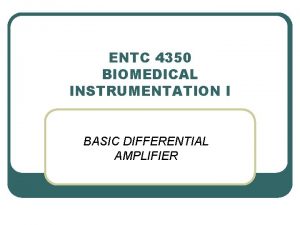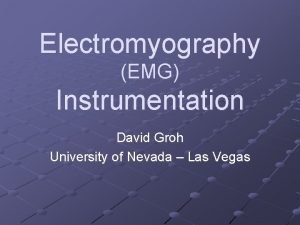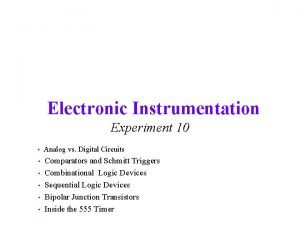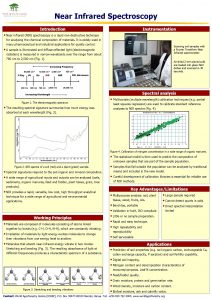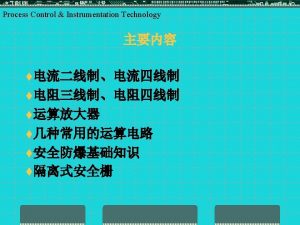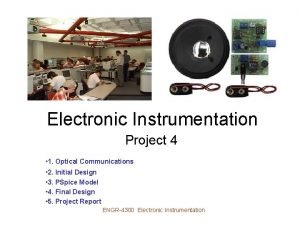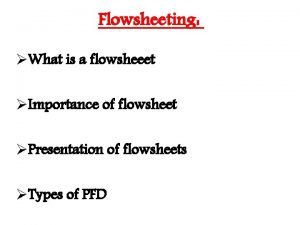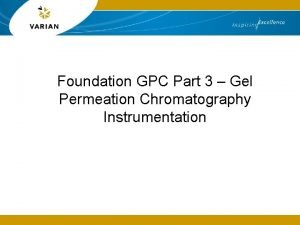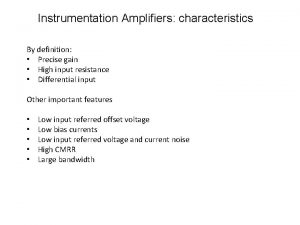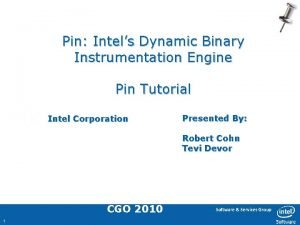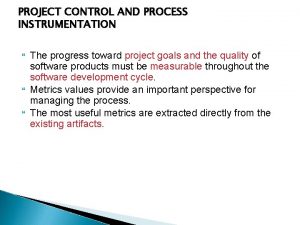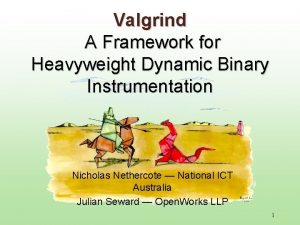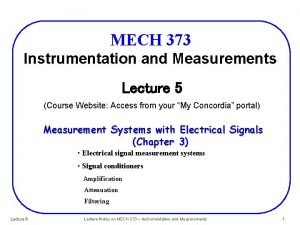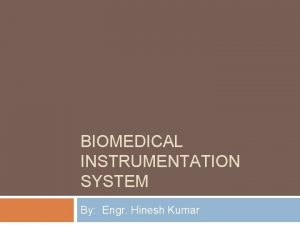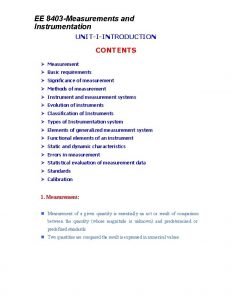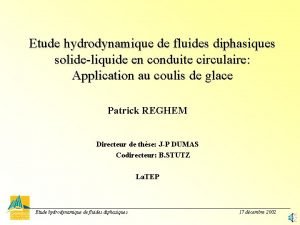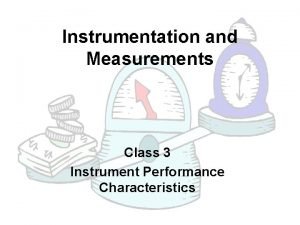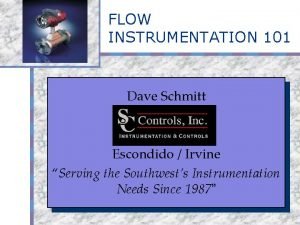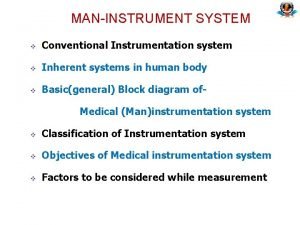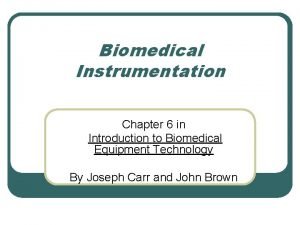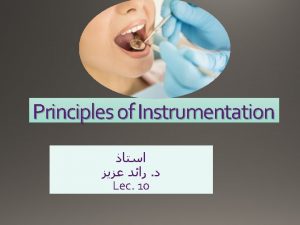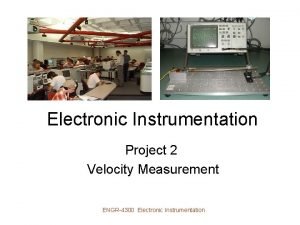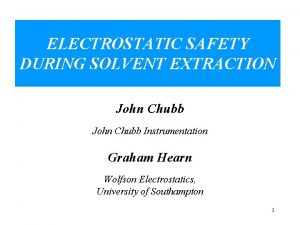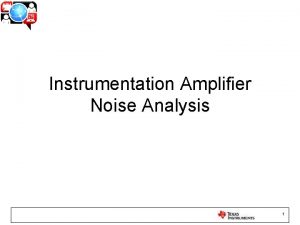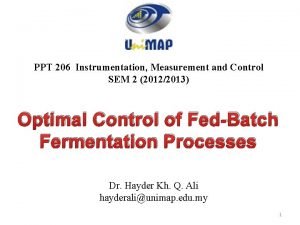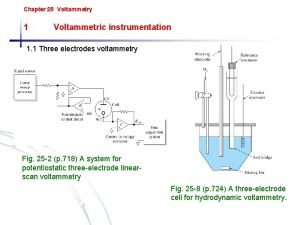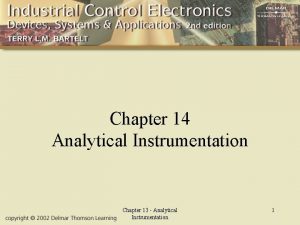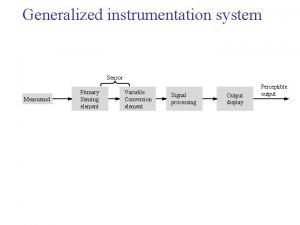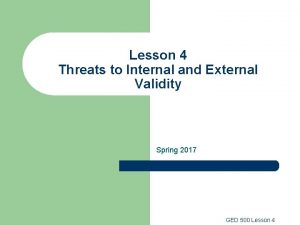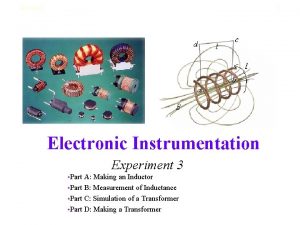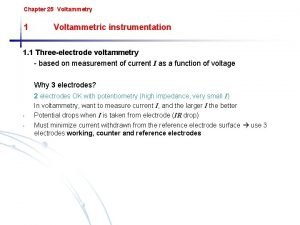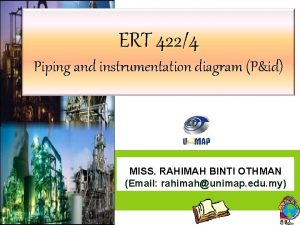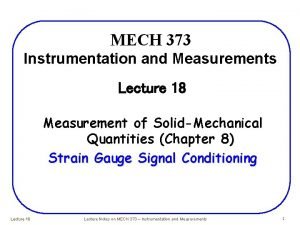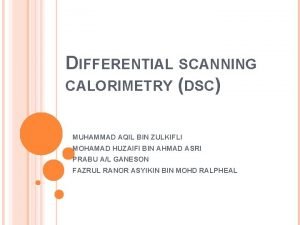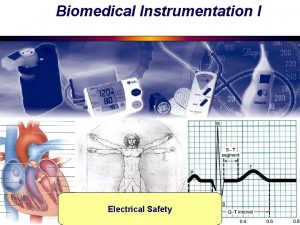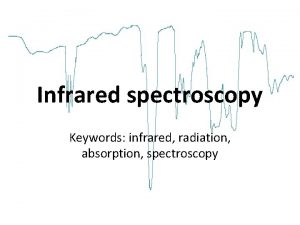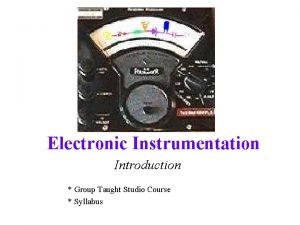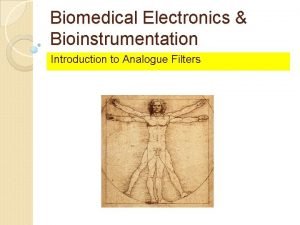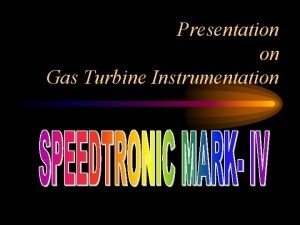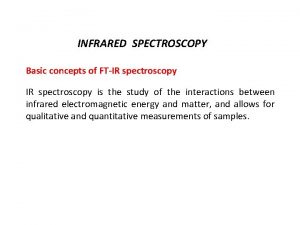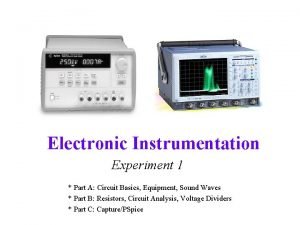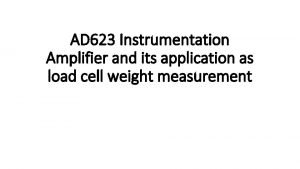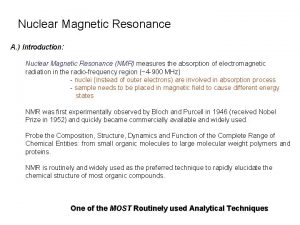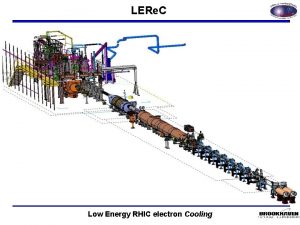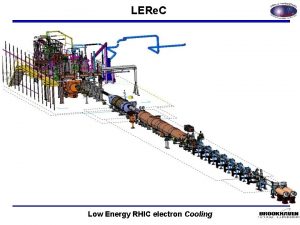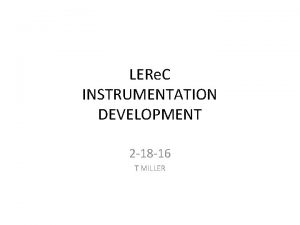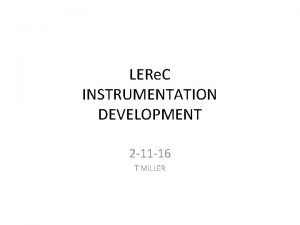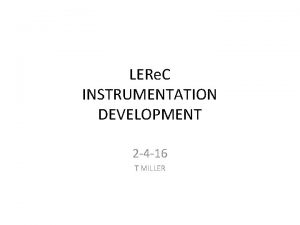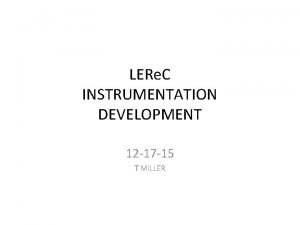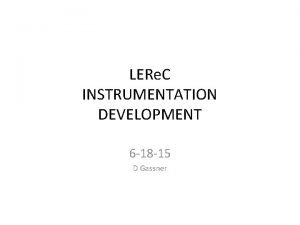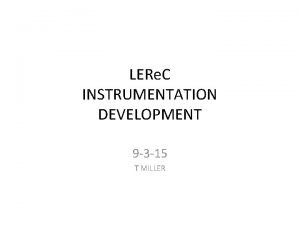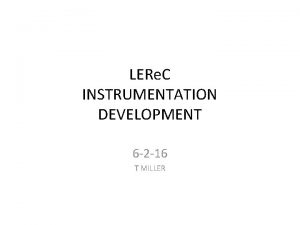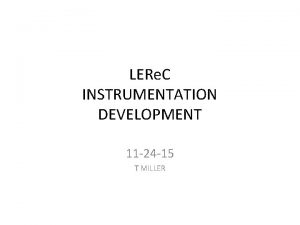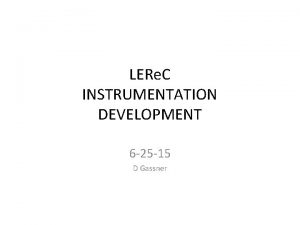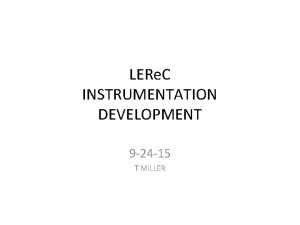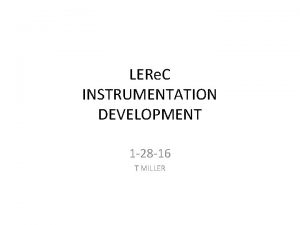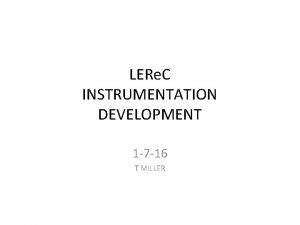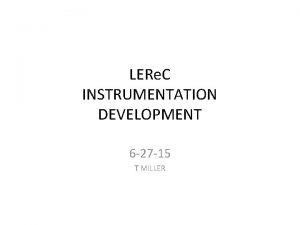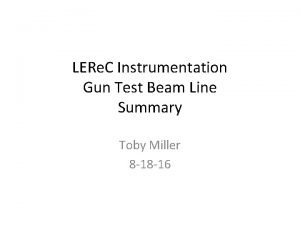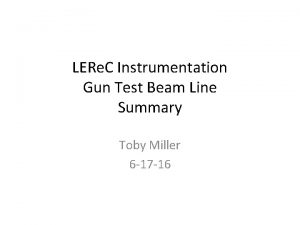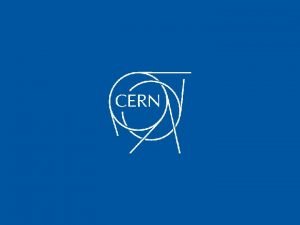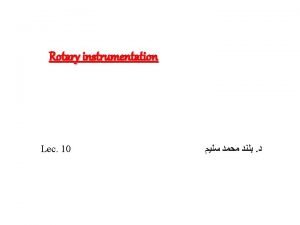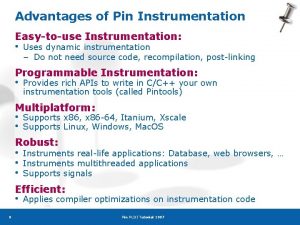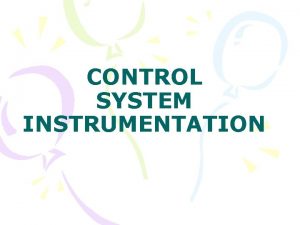LERe C INSTRUMENTATION DEVELOPMENT 3 24 16 T












































![RHIC Orbit Stability • [Per M. Minty] We need to measure the stability of RHIC Orbit Stability • [Per M. Minty] We need to measure the stability of](https://slidetodoc.com/presentation_image_h2/a14cbccb48dc8fa1f1294c0946092292/image-45.jpg)


















- Slides: 63

LERe. C INSTRUMENTATION DEVELOPMENT 3 -24 -16 T MILLER

Topics • Gun commissioning beam line – Emittance • • – Gun cathode camera requested to be color • – Energy Spread – Cooling Section • – Progress report from Peter/Jorg on optics & calc. to determine slit width with new solenoid placement (-135 mm) Layout Conerns • • placement of the PM at the end of the transport line. New layout didn’t show quadrupoles before and after the 180 deg. magnet. Are these necessary? Diagnostic Beam Line – – • Needs to be isolated with ceramic break to provide FC signal Transport & Cooling Beam Lines – • Distinguish laser from parts of cathode and background illumination (request initiated on Ce. C – VL) Gun Profile Monitor • • Gary working on redesign of mask actuator & chamber Progress report from Chuyu/Jorg on optics & calc. of drift distance YAG crystal exposure: can take one pulse but cooling time is too long … update from Peter T. Likely still need kicker & dump Beam Dump Line – Layout • • – 3 rd BPM added after dipole (OK? ) Current layout missing DCCT, 3 rd BPM (maybe no correctors) Need to confirm # magnets… High Power On-Line Profile Monitor • • Extraction Line: use of one fast magnet acceptable upstream of the dump defocusing quad? Need to confirm the optics? Add quad to scheme to also measure emittance?

Machine Layout 64 m to IP 2 Commissioning Diagnostic Line 1 704 MHz Cu Cavity e- COOLING in Yellow RHIC ring RHIC TRIPLET e 180° Bending Magnet 2. 1 GHz Cu Cavity 9 MHz Cu Cavity RHIC DX COOLING in Blue RHIC ring 20° Bending Magnets Beam Dump Updated Layout Symbolic Layout of Instrumentation 3 704 SRF Booster Cavity DC e- Gun

Priorities From: "Fedotov, Alexei" <fedotov@bnl. gov> Date: Monday, February 29, 2016 at 10: 19 AM To: Toby Miller <tmiller@bnl. gov> Cc: David Gassner <gassner@bnl. gov>, "Seletskiy, Sergei" <seletskiy@bnl. gov>, "Kayran, Dmitry" <dkayran@bnl. gov>, "Minty, Michiko" <minty@bnl. gov> Subject: RE: update on profile monitor discussion? My take for priorities: 1. 2. 3. March 2016: Finalize everything needed for DC gun test beamline. Finish drawing and start placing orders for needed items. March-May 2016: Finalize everything needed for RF Diagnostics commissioning beamline. Prepare for presentation of this beamline at DOE review (Dry Run April 1). Although this line is scheduled for installation in summer of 2017 only it has to be full defined and frozen by summer of 2016 so that we can proceed with long lead items in the summer of 2016. June-September 2016: Finalize and freeze all remaining and needed diagnostics, including Wire Scanner. Alexei

Gun Commissioning Instrumentation • Gun cathode camera requested to be color • • Injection BPM = 6 Gun Profile Monitor • • Distinguish laser from parts of cathode and background illumination (request initiated on Ce. C – VL) YAG = 3 Needs to be isolated with ceramic break to provide FC signal ICT = 1 Emittance • • DCCT = 1 Gary working on redesign of mask actuator & chamber Progress report from Chuyu/Jorg on optics & calc. of drift distance Emittance Slit = 1 Halo Pairs = 2 Faraday Cup (& pick-ups) = 5 Axes of Motion = 9 Isolated Beam Dump Faraday Halo Monitor Cup Pair(s) (4 Gt. B Sol + 4 Halo. Mon + 2 RF cavity) Profile Monitor BPM ICT Profile Monitor Corrector DCCT BPM Beam Dia. 38 mm Emittance Slit BPM Profile Monitor BPM(s) Faraday Cup Beam Dia. 29 mm 2. 1 GHz Warm Cavity Quadrupoles Solenoid Corrector Beam Dia. 32 mm Solenoid Corrector(s) Solenoid Corrector Solenoids with corrector & quad coils

Gun Profile Monitor • Profile monitor (insertable YAG) – 19 x 19 mm – Isolated for FC pick-up

Emittance Measurement: Multi-Slit Mask in Injection Section • • Low Power Operations Only New Dual axis design for Horizontal & Vertical measurements chosen for $4 k additional for new actuator. • • The ERL multislit mask will not work for LERe. C. Simulation results for a 400 ke. V beam : – – • Simulation results for a 1. 6 Me. V beam: – – • Using a mask with Slit width 0. 15 mm, slit spacing 1. 2 mm the drift space is 1 m. • Real emittance: 0. 414456561932 • Sampled emittance: 0. 416869820292 • Measured emittance: 0. 325469730076 THUS: two different masks are required at two different distances – – • Using a mask with a 0. 15 mm slit width &, 2. 5 mm spacing drift space is 2. 5 m • Real emittance: 0. 655251966295 • Sampled emittance: 0. 629857938323 • Measured emittance: 0. 623495500861 Mask cost = $3 k ea. 2 nd station Vacuum chamber & actuator = $15 k (unburdened) Current approach is 3 -pos pluging H + V single slits with scanned beam using 2 correctors 7

PM left out of layout – where to place? Scope: Transport YAG Additional BPM & corrector requested by Dmitry BPM Quadrupole BPM 704 MHz Warm Cavity BPM BPM Corrector(s) 8 locations 9 MHz Warm Cavity e-Beam Transport BPM = 10 (incl. new 1 for diag. B/L) YAG = 1 Axes of Motion = 2 (1 / RF cavity) 8 BPM Solenoid(s) 8 locations BPM

Energy Spread Measurement (angle measurement) 365 mm Increased to 500 244 mm 280 mm R Dipole core Update on slit width: 02/01/16

Merger Beam Line • Transport magnets are all bipolar: • Dipoles • Quads • Correctors • Trims • Update on power supply ripple issue : • Ripple vs frequency study • that is a factor of 10 better than the first estimate. Using only the 60 Hz ripple the emittance blow-up is only 1%. • Need for upgrade of power supply / single supply? • Single supply with shunt supply on one dipole • Single supply with active loads on both dipoles To Commissioning Flying YAG Wire Beam Line From Electron Transport BPM e-Beam Transport BPM To Cooling Section 50 V 20 A kepco ps PS was running at 50 V, -17 A, R=2. 9 ohms, L=17 m. H Frequenc V Ripple y (Hz) (u. Vrms) 60 1390 120 1380 150 335 184 113 542 188 665 172 781 98. 7 902 86 10000 1170 20000 568 30000 123 60000 9. 87 97000 691 154000 116 191000 327 380000 41. 2 BPM = 2 YAG = 1 Au Ion Beam Yellow Ring 10 Flying Wire = 1

Commissioning Beam Line – Need dump design • 1. 5 um absorption depth lightens thermal shock • Kicker plates proposed with defocusing effects • Corrector added before deflecting cavity • BPM added after deflecting cavity Beam Sampling Technique for high power single macro bunch measurements LASER Kicker – Single Layer Mu-Metal shielding should be installed – Simulations & calculations suggest phase sensitivity exceeds requriements for cooling RF Settling Time ~250μs Full power on dump • Confirmation from AP pending. . . Moved BPM requested by Dmitry – Alternative to dump & kicker being studied: • YAG & gated camera with 250 us pulse trains • Cooling time too long. . . Scanning YAG Profile Monitor & Faraday Cup Commissioning B/L YAG = 3 HVDC Deflector YAG & Slit Defining Slit = 1 BPM = 3 (+1 in transport) Correctors = 3 (+1 in transport) Solenoid Corrector Camera with Quadrupole BPM Deflecting Cavity (704 MHz) Axes of Motion = 2 (1 / Scan. YAG + 1 / RF cavity) Additional BPM & corrector requested by Dmitry Corrector image intensifier Fixed YAG Faraday Cup = 2 Instrumentation Exposure ~10μs Additional BPM & corrector requested by Dmitry Medium Power Beam Dump er erg M To ction Se (Full Power ~250μs) Beam Sampling Technique: Dumps all beam before RF cavity steady state condition is reached; thereby providing low average power samples representative of steady state high power beam. 11 From Transport Section

YAG Exposure Limit • Temperature rise of YAG with long DC pulse and linear response. – 5 ke. V electrons, – 97 m. A DC – for 1200 us ΔT = 194 K Calculations by Sergei Seletski & Peter Thieberger Dated: 3 -24 -17

Temp rise of YAG in LERe. C • 250 us long train of macrobunches: – 130 p. C/bunch – 1. 6 Me. V ΔT = 66 K Steady State temp = 195 C @ 10 s rep rate – Charge: • 130 p. C @ 1. 6 Me. V • 200 p. C @ 2. 7 Me. V Calculations by Sergei Seletski & Peter Thieberger Dated: 3 -24 -17

Scope: Cooling Sections Solenoid moved 135 mm New (17 th) BPM for angle measurement Hybrid BPM + YAG +Slt YAG 180 Deg Dipole Hybrid BPM + YAG +slit Scanning High-field Em-Slit Solenoid Quadrupole Needed ? YAG BPMs (17) Scanning Em-Slit Quadrupole Needed ? Cooling Sections BPM = 17 (15 dual plane chambers) Purchased 18, 14 installed as of 3 -17 -16 YAG = 6 Scanning Em-Slit = 2 Energy Spread Slit = 1 Axes of Motion = 2 (for scanning Em-Slits) 14 BPM YAG In from Merger Out to Extraction

Scope: Extraction How many magnets? How many BPMs? Current model is missing BPMs, DCCT, and may not have corrector magnets. Blue Ring Au Ion Beam From Cooling Section BPM Additional BPM prudent after dipole Defocusing Quadrapole BPM Extraction BPM = 3 (incl. new one after dipole) YAG = 1 DCCT = 1 Faraday Cup = 1 Wire scanner Faraday Cup (Beam Dump) YAG DCCT • New location for high power on-line profile measurement. • Need fast magnet • Add quad for emittance meas? Wire scanner = 1 15 BLM Cage for loss distribution measurement

Gun-to-Booster Layout Motorized Laser Mirror • • Laser Port OUT Laser Entry port moved downstream. Laser mirrors with motorized insertion to allow positioning for on-axis laser tests of the cathode. Laser Port IN • Profile monitor positioned downsteam of both laser mirrors to clear the laser IN & OUT. Profile Monitor Motorized Laser Mirror

New Layout complete with ion clearing electrodes

BPM Pick-Ups – Buttons easier to implement than striplines – 15 mm offers ~2. 7 X signal than 9 mm from ERL but cost ~$30 k more – In-Tunnel Testing: • RF output filter boards • 707 MHz filter and 40 d. B amplifier board – Chambers: 20 x $1190 = $23, 800 (only budgeted for 10 in estimate!) – 20 BPMs with 90 15 mm MPF buttons = $44, 640 {budgeted $36 k in the estimate) – Total: $68, 440 (budgeted$49 k in estimate) • Peter’s Homodyne (baseband receiver) approach to BPM electronics Ion Clearing • Use of BPM buttons in the Gun-to-Booster is planned – Update to model pending availability of space • Installation of long thin HV wires • Cornell experience: 5 us gap every millisecond – Physicist must estimate required timing MPF, Q 8425 -2

Ion Clearing From: Bruce Matthew Dunham <bruce. dunham@cornell. edu> Date: Monday, February 22, 2016 at 1: 28 PM To: Toby Miller <tmiller@bnl. gov> Cc: David Gassner <gassner@bnl. gov>, "Fedotov, Alexei" <fedotov@bnl. gov>, "Minty, Michiko" <minty@bnl. gov>, "Seletskiy, Sergei" <seletskiy@bnl. gov>, "Kayran, Dmitry" <dkayran@bnl. gov>, "Blaskiewicz, Michael M" <blaskiewicz@bnl. gov>, "Kewisch, Jorg" <jorg@bnl. gov>, "Pinayev, Igor" <pinayev@bnl. gov> Subject: RE: limitation in DC gun performance mitigated by ion clearing [if gte mso 9]><xml> <o: shapedefaults v: ext="edit" spidmax="1026" /> </xml><![endif][if gte mso 9]><xml> <o: shapelayout v: ext="edit"> <o: idmap v: ext="edit" data="1" /> </o: shapelayout></xml><![endif] Well, we recently did runs with just the gun, 350 k. V, 1300 MHz laser rep rate. We were attempting to study what causes the system to trip off during high current runs. In the past, we would have a trip once every few hours, but could not figure out the source of the problem (RF or gun). With just the gun, we still experienced trips (typically due to gun power supply overcurrent limit), sometimes as much as every 20 minutes. We then applied voltage to a clearing electrode, just downstream of the second solenoid after the gun, and then we could run for much longer periods of time. We did one continuous run of 24 hours without a single beam trip, at 20 m. A. We could also use clearing gaps (in the laser beam), to achieve similar results. Above 40 m. A, we had more trips, and the clearing electrodes did not seem as effective. We still puzzle about the exact cause of the gun trips. I don’t see how a burst of ions could cause the problem. Maybe some strange positive feedback? Or perhaps, dust is getting ionized, trapped in the beam potential, and making its ways back to the gun – a spec of dust on the electrode could cause the gun to trip. In the new gun, one can bias the anode to reject ions from outside of the gun, which should help. In the real beamline, the RF/SRF cavities may help to block dust/ions. If it is dust or particle related, you should plan on taking extreme measures during assembly to keep everything clean. I will certainly be more careful than usual during our rebuild now. Bruce

Gun-to-Booster Impedance Simulation valve + anode valve anode mirrors Ø About 60% is due to the anode geometry Ø This section has a large energy spread factor (0. 88 V/p. C, RMS). Ø The two bellow sections make a ~7% contribution. The design should be improved by using larger ID bellows. Ø The mirrors make a ~10% contribution to the energy spread Ø The valve makes no significant contribution to the energy spread. Ø That leaves ~23% unaccounted for, part of which is probably due to the apertures in the vacuum chamber Ø The valve is the main source of a trapped mode at ~1 GHz, and, together with the anode, one at ~4. 6 GHz, which are not acceptable. Note that the valve housing is modelled as empty, and that therefore the real resonances will differ. Ø Possible solutions to the valve problem: § § Bridge the gap when the valve is open Introduce sufficient ferrite absorbers to dampen the oscillations. Ø The larges resonance (at ~6. 8 GHz) is due to the anode. This is part of the Cornell DC gun design. I don’t know if there is anything we can do about this. Data & Conclusion courtesy of P. Thieberger Anode Valve Bellows Mirrors Average Energy -loss (V/p. C) yes yes no yes yes yes no 1. 52 1. 16 1. 49 0. 78 1. 38 Energyspread (V/p. C RMS) 0. 88 0. 82 0. 35 0. 79 Summary of energy loss and energy spread

Particle Studio simulations for the enlarged aperture anode region (P. Thieberger 2/23/2016) Mirrors with ferrite Complete area Anode by itself standard filled Filled, 6 mm beam offset Energy Loss Factor (V/p. C) 0. 83 0. 78 0. 71 0. 66 0. 81 RMS Energy spread factor (V/p. C) 0. 65 0. 51 0. 57 0. 41 0. 47 1) The filled anode design reduces the energy spread contribution by ~0. 15 V/p. C 2) The anode insulator should probably be bypassed with capacitors to avoid the oscillations 3) The only resonances left, after all the improvements, are those caused by the mirrors. We need to decide if ferrite damping should be investigated. 4) Beam offset (if any) doesn’t make much difference for energy spread. Mirrors with ferrite

99. 41” 19. 68” 72. 87” 0” 49. 9 2” 67. 6

Aperture Study – – – ICT – 60. 4 mm ID (2. 37”) DCCT – 1. 87” ID Profile Monitor – 2. 87” max cube port ID Emittance Slit mask – new chamber TBD Halo Monitors – new chamber TBD • SOLUTION: New Optics affords smaller beam • • NEW OPTICS Solenoid added in place of SRF booster. Small aperture of 1. 875” in DCCT no longer an issue. Smaller beam is able to be bent into the dump.

ID 1. 87 BP M ICT BP M CT DC So len o id av ity id no z. C GH S 2 2. 1 ole ER LS no id ole LS ER r. S ge er M rs & ito on M Re CP LE alo LH ile ro f Pic ps k-u or on it M ro L fil e. M ER DCC LE T on m ito itt r an ce ER Sli LI t CT ER ER le ipo °d 20 p Du m Re CP ea m LE LB ER Injection layout DC Gun 704 SRF Cavity (not shown)

NMR Probe for 180° Dipole feedback on magnetic field • NMR Probe • 170 Gauss, 20 milligauss noise, without any signal processing, • NMR reading at 10 Hz – Tests underway • signal processing planned to improve resolution • Lengthen probe & bend away from beam plane – Still waiting on proposal for integrated power supply

Energy Spread Meas. Error • BPM distance from slit: the rms error energy will be significantly reduced by increasing this distance from 365 to 500 mm. The quality of the energy regulation depends on these measurements.

Profile Monitors – YAG Scintillator (Low Power Only) 5 Stations from ERL • Radiabeam product as per BNL specification • For 2. 38”ID beam pipe • Dual screen/slit (3 of 5) • 100μm YAG • OTR (Al/Si) New Stations in Cooling • Low Impedance Design • Al coated, 100μm YAG • 45 mm aperture • Cu mirror @ 45° • Ferrite compensated New Designs (YAG) • (1) Injection Laser Cross • (1) Long. Phase Sp. Mon. • Fixed position • (1) Electrostatic Energy Spectr. • Scanning position High Power • Compact offset cam design • 9 μm carbon fiber @ 20 m/s • accelerate/coast/decelerate • PMT detects X‐rays generated by the scattered electrons Drawings Courtesy Radiabeam Technologies 3 position pneumatic actuator Beam path am on Be Electr 25 x 15 cm YAG 40 mm YAG Ferrite Compensated Transport: *Preparing model of existing chambers with ferrite for PS modeling *May have to design new chambers Photo courtesy of B. Dunham, Cornell Cooling section: *3 chambers in, 2 out *No ground contacts installed: searching for retrofit options 27

Transport Line Profile Monitors • ERL PM chamber mods for LERe. C transport • Simulations pending

Cathode Inspection • Inspection through laser exit port • Optics: ~12” x 18” – – – – 2” Mirror with aperture 2” Dichroic mirror 2” turning mirror Collimated light source Camera & Lens Laser power sensor

Notes from this meeting (3 -24 -16) • Gun Commissioning Beam Line – – – • Transport Beam Line – – • – A study to determine the exposure limits of the YAG crystals was made. Tests at e. Lens demonstrated linear response of YAG up to 1200 us DC e-beam pulses of 97 m. A @ 5 ke. V. This resulted in a calculated ΔT=66 K. Repeated shots of 250 us long macrobunch trains of 130 p. C/bunch @ 1. 6 Me. V in LERe. C results in a similar ΔT if pulse rep rate is limited to 10 seconds. Thus, we can remove the kicker and beam dump from the design; however, the optics of the PM’s require optics an upgrade with a” tilted lens” to image the YAG crystals at 45° due to the limited depth of field. (~$2500 per PM) • Question: will this be required for all 3 PM’s in this line or only the one downstream of the deflecting cavity? Cooling Section – – – • The PM was decided to be placed just before the high field solenoid (last solenoid in the beam line). The BPM and corrector added by Dmitry at the end will be reviewed by Dmitry to determine if the upstream BPM is sufficient or if we really do need the additional BPM in this line. Diagnostic Beam Line – • Emittance: Jorg finished the new simulations for 1. 6 Me. V beam and Chuyu is working on determining the drift distance range between the PM and emittance slit in the Gun commissioning beam line. Cathode Imaging: Vladimir’s requested was discussed, with agreement, to change the cathode imaging camera to a color camera in order to better resolve the laser light from the background on the cathode. This was requested for Ce. C and for LERe. C. This will be a challenge for controls to upgrade their custom written drivers for Linux. Profile Monitor: Dmitry’s request was discussed for isolating the YAG crystal holder in the Gun PM so as to collect charge from the beam as a FC during early gun commissioning. This needs to be incorporated into the design. The energy spread slit width calculation will be DELAYED as considerable work in coordinating optics and simulations is required before confirming the 135 mm move of the solenoid. This will be delayed until after efforts let up from designing the Gun commissioning line. Alexei announced that no cooling section devices will be installed this shutdown to allow time to prepare for the Gun commissioning beam line. All cooling section device installations will be delayed until next year’s shutdown. The placement of the two quadrupoles will also be delayed until proper optics & simulations can be made and reviewed. In any case, they need to be placed on the side of the solenoids closest to the 180 degree dipole. Dump Beam Line – – Karim’s current layout only shows one solenoid and two quadrupoles and one dipole. This does not agree with previous layouts. Our current instrumentation estimate includes 3 BPMs (assuming two solenoids before the dipole). Final optics of the extraction line are yet to be completed. Jorg explained that the beam makes it into the dump without any solenoids in the extraction line. The possiblity of installing the high power profile monitor (scanning beam technique) in the extraction was discussed but eventually CANCELED all together due to the added complexity of optics required in the extraction line to maintain beam quality through the extraction line in order to support a proper profile measurement. • We will rely on the YAG PM in the extraction line to measure the high power profile with single macro bunches only.

Notes from previous meeting (3 -17 -16) • Diagnostic Beam Line – – No reductions in the beam line plans. The question of need for the Longitudinal Phase Monitor was discussed and explained again that it is required in order to set up the RF cavity responses so that the beam parameters of a single macrobunch will be equivalent to a train of macro bunches. Work is underway to prepare the estimate for the DOE review. Discussed eiliminating the fast kicker & dump and expose the YAG to the full 260 us of macro pulses. • Suggested to remove the mirror and tilt the YAG crystal at 45 degrees. • Suggested that we study the YAG exposure limits – – Need to see simulation, calculations & design of kicker beam dump • • Proposed to use a sawtooth beam dump surface to for normal incidence angle Scattered electrons will propagate down beam line and flood instruments during kick. – – • Solenoid shown between PM & slit. • • – Solenoid planned to be turned off for measurement Demagnetizing cycle of the solenoid will likely be required Drift distance and component layout • • • Jorg & Chuyu completed the emittance slit study for 400 ke. V. Jorg is still working on extracting the beam parameters of the 1. 6 Me. V case so that Chuyu can calculate the final drift distance between PM & Emittance slit in the Gun Commissioning Beam Line. It was unclear what the drift distance depends on – should be insensitive… High Power On-Line Profile Monitor – – – • Does kick angle need to be much greater to get beam out of the beam line? Will gating the camera effectively ignore the shine before the measurement? Emittance Slit System – • This would require a special tilted lens optical system to compensate for the limited depth of field over the tilted YAG screen Needed only in the extraction beam line, because the bunches see different focusing from ions due to relative positions wrt the electon beam. This will help to set the solenoid strengths. Using only one fast magnet may be acceptable since beam in defocused by the quad just before the dump. Plus we don't care about sextupole components in kicker magnet field. However, be ware of the radiation from the dump interfereing with the profile measurement (no PMT - must use electrical signal from the wire). M. B. suggested adding quadrupole to this for an added emittance measurement. Beam Line Layout – Still need to determine the placement of the PM at the end of the transport line, before the merger.

Notes from previous meeting (3 -3 -16) • Emittance Measurement – Most of the meeting was consumed by a debate over the Gun test beam line emittance slit measurement technique of fixed slit & scanning e-beam vs. scanning slit vs. multislit. – The multislit case works well at 400 ke. V but shows 25% discrepancy at 1. 6 Me. V and requires 2. 5 m and 1 m drift spaces – thus requiring two separate mask stations ($$$). – The final decision was taken by Alexei just after the meeting to use the ERL mask actuator, buy a new two position actuator and dual single slit mask (H + V) and use two correctors to scan the beam over the slit. • ICT – It was decided that a shield needs to be designed for the ceramic in the ICT (just downstream of the booster cavity) just like what was done for the DCCT by Scott Seberg.

Notes from previous meeting (2/25/16) • BPMs: Rob Michnoff presented the test results with the buttons, cables & electronics. – – RESULTS: • Use ERL 9 mm buttons in Transport • Install local switches & amplifiers in tunnel • Note that the measurements were based on 78, 000 samples averaged over 1 sec. Concerns: • Tests were made with 25 m. V pulse that is shorter than what is planned for. A model of the input filter needs to be made to study the • • Ion Clearing: – • – The ERL multislit mask will not work for LERe. C. However, simulations by Chuyu & Jorg show that a mask with a 0. 15 mm slit width &, 2. 5 mm spacing, can produce the following results for the 400 ke. V beam: • Real emittance: 0. 655251966295 • Sampled emittance: 0. 629857938323 • Measured emittance: 0. 623495500861 Further study is planned for the two higher energies of 1. 6 and 2. 7 Me. V. Laser Mirrors: – – – • Bruce Dunham confirmed in an email that ion clearing was useful in surpassing an intensity limit at ~20 m. A between the Gun and Booster; where the gun would trip often on overcurrent before. Emittance Measurement: – • expected response with longer bunches. It was suggested to use a 78 k. Hz side band around the 704 MHz to avoid noise from the RF systems at the fundamental frequency. Impedance due to the laser mirrors has been dramatically reduced by adding ferrite beneath the mirror. There is a current debate over using brittle ferrite versus a sliding ground contact that can produce particulates. Given no adjustability of the cathode surface angle, there is a risk that the reflected laser may fall outside of the range of motion of the laser extraction mirror. A comprehensive study of the angle tolerance of the cathode versus the available aperture of the reflected laser through the extraction mirror is required. Entry laser mirror now has all three axes of manually controlled motion (X, Y, Z) so that it can be inserted & retraced for on-axis cathode-laser tests. The exit laser mirror has only X & Y manually controlled motion. Merger Dipole ripple & emittance – – New ripple spectral studies show that considering only the contribution from the 60 Hz ripple, the emittance blow up is only 1%, compared to the previously estimated 50% increase. We await a final decision on the use of the ERL 20 A power supplies.

Meeting notes from this previous (2/18/16) • Gun Beam Line: – Correctors will be installed every meter in Gun Test Beam Line and will need to be air core – Impedance too high at the anode. Cornell has submitted a sketch of a modification they can make to taper the inner diameter of the anode. • • • – – Ion Clearing – – – Will a bias voltage of several hundred volts be sufficient with negligible influence on the 1. 6 Me. V beam? The ERL PM chambers are being modeled with ferrites for use in LERe. C. It was suggested to use curved inserts into the unused ports of the 6 -way cubes to improve the impedance of the chamber. The model needs to be updated and resent to Peter for PS sim. We need to gain insight in how fast we can run a hysteresis cycle on solid core dipoles to determine if we really need a laminated core in the merger dipole. Animesh’s study of the multiple components in the dipoles was done at 10 A where LERe. C will be operated at 2. 9 A. Thus, the study must be repeated at our lowest operating current. With the results we can decide if unipolar hysteresis cycling (as done in Animesh’s tests) will be sufficient or if we need to run bipolar cycles. We need to know from Don Brunoif his corrector supplies are unipolar or bipolar and what current range they are planned for. Commissioning Diagnostic Beam Line: – – – – • – Magnet hysteresis cycling: – – • Cornell used 5 us/ms. Will 1 turn per 100 turns work for LERe. C? Will a design for long stretched wires through the transport work? Profile Monitors – • We need information on actuators to properly plan for the required motion control. The need for ion clearing in the transport still needs to be finalized. • • • Peter’s impedance simulations have not taken this into account. This needs to be re-evaluated in the PS sim. We should confirm with Cornell that their energy spread calculations DO take this into account. A mock-up of the cathode imaging technique via the laser extraction port needs to be planned in order to validate the plan to remove the cathode inspection plunging mirror. Laser mirrors now equipped with motorized insertion to allow for cathode testing with on-axis laser beams. • • Peter needs this to be added to the model to rerun the simulation. Peter’s model didn’t have a ceramic break to support & isolate the anode. The model for PS sim needs to be updated with this. Off axis beam on cathode: • • – Wuzheng already has a model for a design. BPMs: – The design of an effective beam dump is of utmost importance. Thermal simulations thus far have been based on surface heating with a 2 degree incidence angle which does not work. Peter Thieberger found that a conservative absorption depth of 1. 5 mm in Titanium. This will improve the efficiency of the current design. We need to have the calculations rerun with the new absorption depth to decide whether or not to further pursue the current instrument design. Dmitry suggested a larger beam pipe for this line and to increase the beam size to reduce the deposited energy density in the dump. Dave suggested that the kicker electrodes be made with a quadrupole component to defocus the beam and spread it over a larger surface area in the dump. We still need to model the design of the kicker in PS for impedance. We need a sloping transition into the electrostatic deflector’s very large diameter The entire spectrometer line should be shielded in Mu-Metal; however, the need for shielding on the rest of the diagnostic beam line was questionable. No update this week. BPM group is working on a signal response chart for AP review.

Meeting notes from previous meeting (2/11/16) • Emittance Measurement – – – • Non gaussian beam makes emittance calculation from multislit exposure difficult and relies on assumptions. Debate over mechanical scanning of a single slit vs. scanning the beam (via 1 or 2 correctors) over a stationary slit (plunged in and out) resulted in favor of the scanned beam in lieu of the cost of the mechanical scanner (not included in baseline). Resolution & stability of correctors must be checked. The beam scanned position can be checked using the downstream profile monitor. Gun Test Beam Line – New optics design by Jorg with additional solenoid in place of SRF Booster provides small enough envelope for all apertures. • • Beam can be easily bent into dump on angled branch DCCT can be placed anywhere – • Energy Spread in the cooling section – • • The DCCT was modeled with ERL beam parameters with and without the shield. This should be repeated with LERe. C beam parameters. The shield design may need to be improved. Jorg still needs to confirm if the lattice can support the move of the last solenoid in the yellow cooling section upstream by 135 mm to improve the angle measurement using the new BPM in front of the Hybrid. This has a low priority as this device installation is pushed to the 2017 shutdown. How to measure energy spread of a single bunch? -> not answered… BPMs – – Rob still needs to think about how he will provide phase measurement suitable for Time of Flight measurements. Further debate over 9 mm vs 15 mm buttons for the transport • • • Lesser precision requirement for the transport may not warrent buying new 15 mm buttons Rob hopes that less precision with 15 mm buttons may perclude the need for local amplifiers Peter asserts that once local switches are implemented to mitigate cable mismatches across the wide spectrum, that the addition of amplifier electronics is a small increase to cost and complexity We plan to test the local switches and amplifier arrangement in the Gun Test Beam Line later this Fall. We need to decide soon in order to have time to order the chambers & buttons by the Fall. require further discussion between R. Michnoff & R. Hulsart with K. Mernick & P. Thieberger to work through the simulations and measurements that have been done so far. AP awaits a table of position resolution for respective BPM system configuration types so that Alexei can take a decision as a function of resolution and budget for the project.

• Notes from this meeting (2 -4 -16) Energy Spread Meas. : Pending a lattice confirmation by Jorg, the last solenoid in the yellow cooling section may move upstream by 135 mm to allow the new BPM to sit 500 mm upstream of the Hybrid slit. – – – • • This will improve the energy spread measurement by 17% while sacrificing only 2% of cooling length. This will require modification to the vacuum pipes already fab’d & installed. Moving the bellows may afford some shift without changes to pipes. Rastered Beam Profile Monitor: Design efforts on this instrument will be stopped until AP can define requirements. Gun Commissioning Beam Line: – – Beam is 29 – 38 mm diameter; thus pipe is too small to for the planned dipole. High power dump may have to sit at the straight exit. • • – • How can we measure longitudinal bunch intensity profile? THz bandwidth and 1 ps time resolution preclude the possibility of measuring this over long cables. Answer: NOT POSSIBLE BPM Buttons: There are 16 ERL BPM buttons available for LERe. C. The transport from booster to dump requires all 16, plus 2 for Gun-to-booster plus two more in the diagnostic beam line. These additional 4 shall be new 15 mm buttons from MPF. – – – Based on quote from MPF, buying additional new 15 mm buttons for the entire transport costs ~$22 k. Designing only one new chamber (instead of two for 9 mm & 15 mm) may offset the additional cost of the ~$22 k. This will be investigated. Signal strength gain of ~2. 7 can be had with the 15 mm buttons compared to the 9 mm. Stripline BPMs may still be a viable option. Q/ Could this alleviate the need for local amplifiers? ERL BPM electronics & V 301 electronics will be tested later this fall on the 5 BPMs during the Gun commissioning. • • • How can we measure energy spread without a bend. However, this measurement may be pointless as the energy spread is expected to be as much as a few percent. How can we measure absolute energy without the bend? Answer was to use Time-of-Flight from BPMs. -> To. F in BPM electronics still requries development. 9 mm, 15 mm, striplines ? ? ? Aperture Study: reveals that the DCCT is the only limiting aperture of the ERL instruments. A transition from 2. 375” ID to 1. 875” ID will be required. Merger Dipoles: 1 st dipole requires a laminated core for fast change to diag. B/L. – However 1 m. A of ripple (20 A supply or 2. 5 A load) in the separate supplies causing 50% increase in emittance suggests the need for a single supply with series connection. • • • This would require both dipoles to have laminated cores. Smaller rated supplies would reduce the ripple AND 60 Hz ripple would be common to both supplies. Jorg will work more with Don Bruno to determine if and how to mitigate this concern

Notes from this previous (1 -28 -16) • Profile Monitors – – Work on transport PM’s include making a simplified model file of the ERL vacuum cubes (with limited mod’s) adding ferrite rings for Particle Studio simulations. If not satisfactory for impedance, new chambers will be designed. Ground contact was omitted from the cooling section chambers. A mechanical attachment method is being investigated. Rastered Beam PM • • Dedicated R&D effort required May require a larger diameter beam pipe Should fit between in ~2. 5 m length Will need 3 DC correctors on top of 3 fast kickers to – – – • • If affect on beam impedance is too great, Alexei is willing to give up this instrument in the transport and have only one in the extraction line. Lots of discussion on implementing pulse picking kickers to extract a few bunches to image on a screen. – • • Peter T. found a paper on OTR with 1 Me. V beams; although charge was much higher. » An image intensifier could compensate. » http: //www 2. cose. isu. edu/~yjkim/course/2012 fall/OTR/M. Castellan_NIM_A 357_1995_pp 231. pdf Receiving signal from wire will require high bandwidth electronics Ion Clearing – – • move the beam to the side, insert the wire on chamber center, then kick the beam across & back, retract the wire, and relax the beam back to chamber center. Buttons needed in DC gun area only Gap in electron beam will be sufficient to clear ions in the transport and cooling sections Gun commissioning beam line – Need to calculate multi-slit mask for emittance measurement for 400 ke. V compared to 1. 6 Me. V and 2. 7 Me. V • • • Multiple masks may be required May have to change distance to PM There was talk of installing multiple mask stations at corresponding locations if necessary

• Cathode Imaging: – – – – • Gun Profile Monitor – – • – – – Beam line supposed to be roughly 6 m long Will need corrector magnets every 1 m for operation without booster. Jorg found that our beam will propagate far beyond the length of this beam line. Cornell used BPM time of flight phase measurements to calibrate their Gun HV. Mike asked how they calibrated the time measurent… no response. Dimitry wants to measure pulse to pulse amplitude stability for <5% requirement. Zhi plans to implement a laser pulse monitor to give phase and amplitude noise measurements using PLL at the RF frequency for an amplitude noise measurement of ~1%. Need solenoids every 2 m and a high power dump to accommodate high current operation of Gun. Beam line will be planned with all instruments as shown – positions to be redefined. The ICT will only provide total charge measurements for – 10 us samples of pulse trains during commissioning. DCCT & ICT will require aperture transitions. Beam Halo – – • We want to avoid adding bias tees to the BPM buttons to combine position measurements with ion clearing. Additional buttons proposed to be added for use as ion clearing electrodes in the gun section Cornell makes their own from feedthroughs and simple flat electrodes. To save space, an 8 -button chamber is proposed to provide position measurement, ion clearing, and phase pick-ups for LLRF Bias voltage of only ~100 V is required, per Bruce. Cornell built a parallel plate device with matched impedance for ion clearing but was expensive. Tests with ac bias showed optimum frequencies and resonant points where ions were quickly swept away. This was indicated by reduced ion-induced radiation on nearby PMT. Gun Commissioning Beam Line – – • As anode is biased to ~500 V or so, an p. A ammeter can be used to monitor cathode condition where increased beam halo from a roughened cathode surface would result in halo depositing current on the anode. The anode bias could be enough to act as an ion clearing electrode but no data to prove yet. Ion Clearing – – – – • Need to check if YAG screen (19 x 19 mm) is large enough to make solenoid scanned emittance measurements using varying beam size on screen. Bruce suggested multiple screen types (Beryllium Oxide, Diamond) for imaging higher beam charges to avoid the low saturation limit of YAG. Gun Anode: – • Notes from previous meeting (1 -21 -16) We will plan to guarantee that the cathode gets inserted such that the activated spot is always in the same location when inserted; thus avoiding a full scan of the laser across the cathode. According to Bruce, Laser s don’t provide full aperture covering the entire cathode. Need to layout optics to confirm. . Bruce argued against the insertable cathode mirror as it is rarely used and its Be. Cu RF seal produces undesirable particulates. Cornell typically uses the laser insertion/extraction ports to peer at the cathode through the laser steering mirrors; although they don’t give a full view of the entire cathode surface. We can use a color camera and illuminate with red light to provide a high contrast to the green laser spot on the surface. Degradation of the cathode surface will result in increased specular reflection – directly visible by this camera. A more important camera to have is one looking through a mirror at the back side of the inserted cathode. A fiducial can be made on the rear of the cathode that indicates the orientation of the activation spot for in-situ confirmation. Thus we decided to remove the plunging on-axis cathode inspection mirror Cornell’s concern was strictly personnel radiation safety and cathode lifetime. Operation in the RHIC tunnel gives rise to concerns of cathode lifetime and risk of quenching the booster SRF cavity. ERL halo monitors planned to be mounted just downstream of the last solenoid in this line. Should be where beam is largest. High Current Profile Measurement – Do we really need it: • • • – – Only mechanism that affects profile from low to high current is suspected to be effects from ion clouds. Thus with ion clearing, do we really need to make the measurement? Other advantage is an online profile measurement – maybe the greater advantage Fast emittance measurements are needed to look for effects of ion clouds since they caue oscillations of the pulse train tail. This may be visible in the raw BPM button signal. Cornell admitted to not having sufficient diagnostics to look for this. Flying wire can do 20 m/s across the beam. Current design flaws include: wire breakage & vibration, vacuum upset during operation. Cornell agrees that this R&D project may not be mature enough for us to rely on. Alternative Rastered Beam Profiler is now the avenue of choice to pursue. • • Dump location would not require a perfectly compensated orbit bump. May not fit in the merger section as spacing between kickers is needed to provide a good lever arm for a 20 m/s beam traversal over the wire.

Back-Up Slides

Emittance -06 -06 Multi-Slit -06 Emitt anc. . . YAG YAG -06 Scanning H+V Slit -06 +00 Envelope 5, 00 E-03 4, 00 E-03 YAG meters 3, 00 E-03 Ne YAGs YAG YAG Envelope X YAG Flying Wire 2, 00 E-03 1, 00 E-03 0, 00 E+00 -1, 00 E-03 40 Envelope Y Elements

Main Beam Line YAGs Transport Section: 25 x 15 mm YAG Ø 12. 5 mm (@2. 5σ) Injection Section: 25 x 15 mm YAG Ø 9. 1 mm (@2. 5σ) Gun Section: 25 mm YAG Ø 10. 75 mm (@2. 5σ) 5, 00 E-03 Envelope 4, 00 E-03 Cooling Section: 45 mm YAG Ø 19 – 22 mm (@2. 5σ) New YAGs YAG YAG 3, 00 E-03 Merger Section: 25 x 15 mm YAG Ø 2 mm (@2. 5σ) Diagnostic Beam Line: 40 mm YAG Ø 15. 5 mm (@2. 5σ) Extraction Line: 40 mm YAG Ø 30 mm (@2. 5σ) YAG Envelope X YAG Flying Wire 2, 00 E-03 1, 00 E-03 YAG , 00 E+00 1, 00 E-03 41 Envelope Y Elements

Commissioning Beam Line YAGs Simulated image on YAG from Deflecting Cavity Commissioning Beam Line: (Long. Ph. Mon) 45 mm YAG ~20 x 20 mm Commissioning Beam Line: (Scanning YAG) 30 mm YAG Ø 3. 25 mm(@2. 5σ) Commissioning Beam Line: (PM with slit) 30 mm YAG Ø 10 mm(@2. 5σ) sx=1. 3 mm sy= 0. 3 mm sx/sy=4. 3 Insertable YAG sx=2 mm sy= 2 mm Dog leg Dipole off 122 cm Solenoid B=0 G Dipole off 10 cm YAG & Slit Scanning YAG sx=0. 65 mm sy= 0. 65 mm 10 cm Dipole Solenoid B=245 G Solenoid B=260 G 42 2. 5 m Static deflection plates Gap=2 cm, max. V=1. 5 k. V, L=50 cm

0 E+00 Dispersion Increased Dispersion(x) with 2 merger solenoids OFF 1, 00 E+01 2, 00 E+01 3, 00 E+01 4, 00 E+01 5, 00 E+01 6, 00 E+01 7, 00 E+01 8, 00 E+01 9, 00 E+01 x. Dispersion y. Dispersion Energy Spread YAG Defining Slit Energy Spread rms Minimum Energy Spread Maximum Energy Spread 43

Stripline BPM study for Transport • Signals in a RHIC type-2 BPM that would be produced by 30 p. C electron bunches in the LERe. C transport line Ø The striplines need to be shorter for 700 MHz rep rate to avoid signal overlap. Ø The striplines can also be narrower since the signal amplitudes are larger than necessary. Ø Narrower striplines will reduce wake loss factors of 5. 8 E-2 and 1. 4 E-2 for the 10 mm and 37 mm rms bunch lengths Stripline BPMs seem to be a viable solution. BPM signals for 30 p. C bunches of rms length 10 mm (blue) and 37 mm (red)
![RHIC Orbit Stability Per M Minty We need to measure the stability of RHIC Orbit Stability • [Per M. Minty] We need to measure the stability of](https://slidetodoc.com/presentation_image_h2/a14cbccb48dc8fa1f1294c0946092292/image-45.jpg)
RHIC Orbit Stability • [Per M. Minty] We need to measure the stability of the absolute position of the RHIC ion beams documenting the effectiveness of – (1) global orbit feedback, which likely is limited by corrector bit resolution (presently 12 -bit) particularly at low beam energies – (2) 10 Hz feedback, which by design (cost savings) included only 1 corrector perturbation; this has worked well so far, but obviously misses the second degree of freedom (position and angle) and the triplets are long (can’t assume point-like excitation) • If the ion beam trajectories vary by more than allowed, paths forward include – higher resolution control of the RHIC corrector dipoles (for global orbit feedback) – additional air-core dipoles for 10 Hz feedback. • We should document beam trajectory variations in sector 1 (LERe. C) and in IR 2 (Ce. C) during RHIC startup and aim to implement localized weighting (ala Chuyu) of BPM measurements for improved trajectory control in these regions.

Summary Analysis of data from FY 14 Au+Au, 7. 3 Ge. V/u run with LERe. C-like lattice in IR 2 (fill 17984): Blue Yellow Variation in average orbits: horizontal (peak-to-peak, microns) vertical 200 150 200 Variation in average angles: horizontal (peak-to-peak, vertical microradians) < 10 <5 < 10 Variation in absolute angle: horizontal (peak-to-peak, microradians) < 10 controlled by orbit feedback controlled by 10 Hz feedback Averaged trajectories : peak-to-peak orbit variations (Q 3+Q 4)/2 ~ 200 microns peak-to-peak relative angle (Q 3 -Q 4)/16. 3 m < 10 microradians Absolute trajectories: peak-to-peak orbit variations at BPMs (Q 1 and Q 3) ~ 400 microns (in blue, less in yellow) peak-to-peak relative angle < 10 microradians (horizontal plan) Orbit displacements (peak-to-peak) < 1/10 th of expected rms electron beam size Angular variations (peak-to-peak) well within 50 microradian tolerance for relative (rms? ) ion-electron beam trajectory divergence

Longitudinal Phase Space Monitor – Commissioning Beam Line Dog leg Dipole off 704 MHz Vertical Deflecting Cavity – Used for optimization and monitoring of phase and amplitude of the – – 122 c m LERe. C RF systems. Scaled from Cornell ERL Injector 1. 3 GHz design. Time varying vertical deflection of bunch from head to tail. Combined with horizontal dispersion from bending magnet (Dx = 1 m at YAG) provides position (time) resolved energy spread along bunch. Very low RF power <500 W at highest beam energy. • Energy Spread – 500μm width on YAG = 1× 10 -3 energy spread (Δρ/ρ) – 100μm resolution on YAG = resolutions of 5% of max Δρ/ρ • Bunch Length – 30 mm on YAG (100μm resolution ) with 3 cm bunch length – Resolution of 30 mm / 100μm = <0. 5% of bunch length Simulations Courtesy of D. Kayran To Electrostatic Energy Spectrometer 2 m Deflecting Cavity (704 MHz) Medium Power Beam Dump (Full Power ~250μs) Solenoid Dipole B=260 G Beam Image on YAG S. Belomestnykh, et al. , “Deflecting cavity for beam diagnostics at Cornell ERL injector, ” Nucl. Instrum. & Methods A 614 (2010) 179 -183. Pulsed Electrostatic Deflector (Kicker) 10 cm Beam’s Initial Longitudinal Phase Space 2 m Solenoid Fixe d YAG Solenoid B=0 G From Transport Section Bunch Length • sx=1. 3 mm sy= 0. 3 mm sx/sy=4. 3 ~500μm sy= 5. 6 mm sz= 32 mm Δρ/ρ Cavity On Cavity Off Deflecting cavity: U=12 k. V f=704 MHz L=2 m 47

Daignostic (“Commissioning”) Beam Line Layout • Beam dump will lengthen to a water cooled beam pipe • Spectrometer will deflect vertically • Spectrometer YAG will scan vertically • ~4” beam pipe between deflector chamber & detector (YAG) chamber

Absolute Energy Measurement – Commissioning Beam Line Insertable YAG sx=2 mm sy= 2 mm Current approach: • ~2 k. V electrostatic deflecting electrodes • Scanning YAG screen (+/- deflection) over 100 mm • Calibration using Tandem ion accelerator • Expected resolution: – – Dipole off YAG & Slit Scanning YAG sx=0. 65 mm sy= 0. 65 mm 10 cm Solenoid B=245 G 50μm optical resolution ÷ 100 mm deflection = 5× 10 -4 which can be improved to compensate for noise with a fixed zoom lens. By centering the spot on the screen using Center-of-Gravity image analysis, the sub-micron scan position gives the absolute energy. 2. 5 m Static deflection plates Gap=2 cm, max. V=1. 5 k. V, L=50 cm All Particles through beam line 3 mm iris 37% transmission Pipe 6 cm 2. 38” ID Scanning YAG Monitor solenoi d Deflection plates ± 1. 67 k. V Fixed Faraday Cup 1. 6 Me. V electrons ± 1. 67 k. V 7 inch travel M Simulations Courtesy of D. Kayran Dy=+/-5 cm Beam KE=1. 6 Me. V sy=. 65 mm sz=. 65 mm Static deflector: U=+/-1. 67 k. V Gap=2 cm Length=50 cm Dist. to PM=2. 5 m 49

2. 5 m Possible repurpose of ERL Di. PM for Scanning YAG (~$30 K savings) KH

40 mm Linear feedthrough w/ 2. 5μm res. micrometer 8” OD chamber Ceramic standoffs Extension springs Deflector plates KH

KH


KH

Recombination Monitor: Ion Collection Recombination Detector – Secondary Cooling Indicator. Collection of recombined ions: • Lost at predictable location • Detector: PMT + Counter • Development underway of a lattice with a dispersion waves in the cold arcs • Roman Pot type detectors envisioned in the cryostat to collect the Au+78 ions. Recombination detector concept showing two ionization detectors mounted in retractable roman pot systems. Courtesy of Peter Thieberger 55

Deuteron Recombination Detector How to proceed? • simulations needed for blue detector Cooling section Courtesy of Peter Thieberger Ø Investigating deuteron-electron recombination for initial electron beam alignment and energy calibration. • Strong, localized signals allow detection starting far from optimal alignment. • Neutral deuterons from deuteron-electron recombination are not deflected in the arcs. • Detectors located outside of the cryostat (red rectangles) will detect these particles and the showers they produce. • Detector telescopes can be used to reduce background if necessary. • The structure of the expected showers will be studied using MCNPX simulations. • A small deflection will result after the neutral deuterium losses its electron when traversing the beam-pipe. This deflection will be calculated and taken into account.

Scanned-Beam Profile Monitor • • • Now the method of choice to pursue Harp processing electronics? Design consideration to pursue 1. 2. 3. 4. 5. 1. 2. 3. 1. 2. 1. wire material selection where secondary emission ≠ electron absorption Suggested materials: Tungsten-Rhenium, Beryllium, Boron Nitride, carbon, etc. max temperature of wire under CW beam @ 20 m/s deflection rate; where CW means continuous macro bunches Magnet Design: Layout? Required distance between kickers in chicane What will fit into the dump line? How many kicker/steerers for local bump (2, 3, or 4) Kicker power supply design: need specs on rise/fall time of pulse need magnet tolerance/quality specs Kicker Vacuum Chamber design Likely ceramic with slotted metal inner beam shield

• Notes from previous meeting (1 -14 -16) High Current Profiles – Wire scanner • – Plan to meed with Bruce Dunham next week to discuss details Scanning-Beam Profile • • – Low energy provides for low current kicker power supply Need ceramic break but with longitudinal wires for image currents that will suppress eddy currents during the magnetic pulse Direct current sense on a plunge able wire Wire can be retractable through a valve for wire replacement Gas Jet Profile was suggested. Peter found a reference to a “curtain” pulsed supersonic gas jet beam profile monitor at this – Aperture scan Insertable apertures in the cooling section can be used to link: https: //jacowfs. jlab. org/conf/y 15/ipac 15/prepress/MOPWI 006. PDF and pictured here to the right. • • – – Dmitry needs to measure beam current from Gun during gun commissioning. • • • – Need to know its distance from the hybrid BPM to calculate angle resolution How much will this distance be able to be increased? What will have to move? The quads shown near the solenoids were modeled on the 180 dipole side of the solenoids. Jorg explained that additional skew quads will be required if they are on the other side of the solenoids (as shown in this presentation). This is desirable so as not to interfere with the angle measurements. ACTION/DECISION REQUIRED! No updated from Caylar on NMR probe yet. Gun Instrumentation – – • Magnet is already fabricated Longitudinal phase measuring line needs a similar 20 agree magnet, which can be made with a laminated core and then swapped with the merger dipole. Energy Measurement in cooling section has a new BPM for angle measurement – – – • Can laser box profile monitor be made isolated to pick-up beam current? Can the ICT be mounted near the gun (before booster installation) for commissioning current measurements? Dmitry will make a list of instruments needed during gun commissioning and how far away from the gun they can be. Laminated core in 20 degree dipole is needed at dog-leg for fast switching to commissioning beam line. – – • approximate beam profile from tails Measure angles of scalloping beam between solenoids Current Measurement – • Looks complicated and the bias on the detector will be a danger to the low energy beam May need to move laser mirrors downstream of the 2 nd solenoid for a clear aperture. May not be enough space! New laser box profile monitor design provides 19 x 19 mm YAG crystal. This was deemed large enough for the expected beam size by the group. Design efforts to continue. Much discussion on how to image cathode through laser injection port. This will be implemented (with risk involved in getting a quality image) and thus will be in addition to the dedicated cathode inspection mirror. Laser mirror positioning study continues. Laser box & instrumentation placement on hold until laser mirror placement is fixed. BPM Systems – – Eight 15 mm buttons for gun requested from MPF with reduced length. Waiting for 2 nd response. Two 15 mm buttons for RF pick-ups will have to be the long design used in Ce. C due to the current chamber design. Rob is planning to employ the use of solid state switches, as used by JLAB, to switch cables to minimize offsets. Peter T. ’s work simulating striplings for the transport section met with lots of questions of why the buttons aren’t sufficient. • • – Igor suggested putting narrow-band ringing filters and amplifiers near the buttons in the tunnel, as Kevin Mernick advocated the use of local amplifiers too. These switches have good results in the stochastic cooling electronics since 2 years. Stripline development wasn’t budgeted for; however new buttons larger than 9 mm were also not budgeted for. Rob is still tracking down slow drifts in tests with long cables and splitters into the RHIC tunnel. Temperature affects are being analyzed. • RHIC Orbit Stability • A concept of the electrostatic spectrometer is complete (3 D model) – – Study started by Michiko; time didn’t allow discussion of the progress. Will be used to build schedule & cost estimate The YAG scanner could be repurposed from the ERL Di. PM (saving ~$30 K) Igor suggested a fixed YAG & optics system with a scanning vacuum chamber attached to bellows • This may conflict with the system’s requirement to be rigid and self-contained but can be considered during the official design effort.

Notes from previous meeting (1/7/16) • DC Gun: – – • Rastered Beam Profile Monitor: – – – • If used during operations, we’ll have to plunge in the filament, make two sweeps across it (back and forth), and remove it. The profile would be generated by plotting the signal from an in-vacuum scintillator (or secondary electron pick-up) against the steering magnet current (predicting beam position). How to pick-up secondary electrons without a biased pick-up (bias could affect the beam) The beam energy is too low for an air-side PMT. Toby will ask the concepst’s author (Mike Tiefenback) about its use at our low energy (1. 6 Me. V). Measurement of profiles with high power beam seems prudent as Cornell showed very different profiles for low and high energy; however, their measurements were taken with varying parameters, putting their results in question. What do we really loose by giving up an online high power profile measurement? The diagnostic beam line can make a sampled measurement. Concerning using the diagnostic beam line (or “commissioning beam line) we may need the 20 degree magnet to have a laminated core to facilitate switching on and off of the magnet from time to time. – • There is a question on which side of the gun to put the laser table in order to clear cryo equipment. Particle Studio simulations have a problem with v<c as is the case in the gun area. It was suggested to simulate based on v=c and scale by the difference in Beta. We need to generate a model of the gun transport suitable for Particle Studio simulation. We’ll need to include the shielded version of the bellows. Cathode imaging was debated without a firm opinion on whether or not it needed to be available during operation or allowed to block the electron beam during imaging. Is it too late to change the core properties of this magnet? Toby will request an update on Caylar’s progress on NMR probe and proposal for magnet power supply integrated with their probe for the 180 magnet.

Notes from last meeting (12/17/15) • The LERe. C gun will be commissioned with a fiber laser transport. – – • Concerning the BPMs in the gun-to-booster section, current test data suggests requiring averaged data over 1 – 10 us long trains of macro bunches to provide 100 um position resolution using the 9 mm buttons. – – – • • We need to calculate how accurate of an angle measurement can be made adding a BPM between the hybrid device and the solenoid. To synchronize the laser to booster RF (with feedback loop) – – • A small meeting may be held with Michiko, Dave, Rob & Alexei to decide if buttons will be sufficient. We are ready to request a quote for MPF to redesign their 15 mm buttons (used at Ce. C) with a much shorter depth. We may plan to center the beam using many turns of beam for good position measurement followed by profile, emittance, energy & energy spread measurements in the single macro bunch mode. We need two BPMs between the 180 dipole and the solenoids to make an accurate beam angle measurement. – • Fear of nonlinearity in the fiber suggests an inability to reproduce the “beer can” shipped laser pulses & macro pulses. Based on experience at the JLAB FEL, we are preparing for the likelihood of needing an evacuated (or dry nitrogen filled) laser transport pipe system. we will add a photodetector to sample the laser just before entering the laser box Kevin(s) Smith & Mernick requested to add a pair of button pick-up electrodes to the laser box to provide beam based feedback to LLRF as well. Concerning imaging of the cathode, a fixed mirror and viewport is cheaper & better than a plunging one as the cathode can be imaged while producing beam. The longitudinal phase monitor (in the commissioning beam line) needs 0. 4 degree resolution for proper energy spread measurement. The current location provides roughly 5 degree resolution based on current optics simulation. – – Michiko will re-evaluate the simulated data. The entire beam line may need to move downstream of the 180 degree dipole. The optics design is waiting on a firm design and impedance analysis of the beam kicker & dump. The optics should be designed so that the beam at the center of the kicker is imaged onto the YAG screen

Notes from previous meeting on 12/3/15 • • 1 st diag. B/L magnet needs to be an ERL 30 degree dipole, 20 degree is shown in this layout. ERL aperture is actually smaller. . . maybe choose the larger aperture dipoles in the ERL dump. George to advise… Discussion of running without booster: need corrector every 1 m, or 2 layers of mumetal, or use long helmholtz coil. . . New goal to run beam without booster, through all planned instrumentation (mostly from ERL) to the FC in the first diagnostic beam line. – – • need to take care to run magnet cables so as not to generate stray fields! Don Burno will look for twisted pair power cable for magnets <20 A. It was suggested to eliminate last dipole before the beam dump. However, this will inceased back shine to the instruments. – • • need to model device for impedance Need to ask Cornel about results with titanium, is it any better than carbon? Optics studies from Dmitry show the same optics as presented to DOE in Nov. (shown here). – – • A back-up plan shall be to image the cathod through the laser entry port and steering mirror using a mirror in air on axis with the laser with an aperture for the laser to pass through. A better alternative is to simply add a fixed mirror and viewport to avoid the plunging mechanism and also allow for cathode imaging simultaneous to beam production. Request for quotation for a magnet power supply was sent today to Caylar to work with the NMR probe for feedback on the magnetic field. Concerning the Flying wire scanner, Igor suggested a carbon sheet to thermally image the profile of the beam. Peter commented that this works for beam finder but suffers from nonlinearities for an accruate profile? Could we back out the nonlinearities? – – • we may change the dump over- focusing quadurpole to a solenoid. Dmitry will look into this. will discuss during design in 2 months. . . It was suggested to elongate the laser box and incorporate the two new ports into the box instead of a cross to provide a plunging cathode imaging mirror. – • Alexei would like to install 8 k. W Ce. C beam dump to test gun next year. Plan to move the YAG (just before 704 MHz warm cavity) upstream to just after the 1 st diag. beam line for next year's test. Open question is whether or not to add BPMs to this portion of the beam line and is any Mu. Metal shielding required. John Hock is involved to apply e. Lens BPM & drift tube designs toward the deflector and kicker designs for LERe. C. Concerning the Electrostatic Energy Spectrometer, the deflector voltage will be increased toward 5 k. V so that the 2 cm gap can be enlarged to accommodate the beam. The gap will be increased to 4 cm. End. Fragment Concerning the recombination monitor, the open issue here is the choice of detector to install inside the cryostat and whether or not to make the detector moveable. A warm motion feedthrough like what is being installed on the Ce. C 700 MHz tuner may be a candidate.

Notes from previous meeting on 11 -24 -15 • CW vs Macro. Bunch beam structure – – • Cathode Imaging – • – – Joe explained during a discussion about the Ferrite modified chambers that we plan to move forward with totally new designs for the profile monitor chambers in order to match the beam line aperture and to correct for impedance. Flying Wire Profile Monitors – • Rob H announced that test results have showed excellent rejection of the 700 MHz electron signal while measuring the low frequency ion signal due to the use of the 10 MHz diplexers (see slide 6). Moreover, significant temperature dependance of the system shows the need for temperature controlled racks for the BPM electronics. One long term drift has yet to be correlated with a cause. More testing with 700 MHz trains of short bursts is necessary to investigate suspected frequency dependance of electrical center of the buttons in the cube. We are investigating faster picosecond pulses, 700 MHz ARB’s and perhaps a properly matched Goubau Line or alternative structure for testing the button cubes. ERL Profile Monitors – • Caylar reported in a video conference this morning that they are making good progress with their NMR-20 instrument and is measuring 166 Gauss with +/50 m. Gauss noise at a 2. 5 Hz measurement rate (400 msec sliding average window). Their goal is a resolution of 20 m. Guass. BPM Testing – • Proposal to add cathode imaging to Cornell Gun design via a penetrated mirror in laser entry port to image cathode along the path of the laser. This depends on the useable aperture of the laser steering mirror that would also be used for imaging the cathode. NMR Probe – • Alex reported that we are buying high power couplers capable of CW operation in the event that CW operation is required. Thus only additional RF power amplifiers would need to be added. It is not yet clear if this is an advantage or disadvantage for BPMs. Certainly, CW operation would eliminate the possibility of usingle electronics boards for ion & electron measurements. But, this would only strengthen the 700 MHz electron beam position measurement. We decided to move forward with requesting a serious quote for the procurement of TWO units from Cornell. We may be fortunate enough that single macro bunch profile measurements of the beam are representative of the high power beam BUT the Flying Wire PM is the only instrument that can provide profile measurement during operation. Longitudinal Phase Space Monitor – Kevin Mernick explained that a recent meeting was held where the parts of the commissioning beam line were assigned to people to work on, as follows. Dmitry will present the beam line optics in a meeting next week. BPMs and solenoids may need to be added. • • • Electrostatic Energy Spectrometer – • Fast Kicker – KM, MMB, KSS Internal Beam dump – JT, MMB Transverse Deflecting Cavity – BX, JT, VV (Cornell) YAG Screens, Cameras – TM Other Diagnostics (BPMs? ) – RM, RH Energy Measurement - MM Beamline Optics – DK, JK Magnet Power Supplies – DB (I’ll at least clue Don in re: this minor side project) Vacuum, Beamline Layout/Construction – JT Peter is working on the preliminary design of the deflector that an ME will be assigned to work on to aid in developing a cost estimate. I (Toby Miller) will work on estimating the YAG profile monitors and associated optics and scanning motion control for the beam line. Recombination Monitor – – – Felix has a promising RHIC lattice that can produce ~8 sigma of separation between Au+78 and Au+79 ions in dispersion bumps in the cold defocusing quads set up using the gamma t quads. A Roman Pots style detector will need to be designed to move a detector into the dispersive space of the beam. CERN is experimenting with installing beam loss monitors inside their crystats. The results could be useful here in choosing a suitable detector. Wolfram pointed out a US vendor of Diamond Detectors, Applied Diamond, Inc. He also suggested considering new Plasma Radiation Detectors being introduced by Integrated Sensors, LLC We discussed installing the double coincidence detectors for deuteron recombination detection as the detectors are outside of the vacuum. The yellow detector in the IP should work well but the blue detector has lots of material impeding the signal and will require further simulation to determine its effectiveness.

 Hplc instrumentation diagram
Hplc instrumentation diagram Cryogenic instrumentation
Cryogenic instrumentation Vienna conference on instrumentation
Vienna conference on instrumentation Turbine supervisory instrumentation
Turbine supervisory instrumentation Temperature gradient
Temperature gradient Measuring system block diagram
Measuring system block diagram Differential amplifier in biomedical instrumentation
Differential amplifier in biomedical instrumentation What are active instruments
What are active instruments Emg instrumentation
Emg instrumentation Electronique instrumentation
Electronique instrumentation Near infrared spectroscopy instrumentation
Near infrared spectroscopy instrumentation Instrumentation of centrifugation
Instrumentation of centrifugation Process control instrumentation technology
Process control instrumentation technology Electronique instrumentation
Electronique instrumentation Process flow sheeting
Process flow sheeting Gel chromatography instrumentation
Gel chromatography instrumentation Characteristics of instrumentation amplifier
Characteristics of instrumentation amplifier Aami 2018 standards
Aami 2018 standards Parts of chapter 3 research
Parts of chapter 3 research Smart plant instrumentation
Smart plant instrumentation Pia selector
Pia selector Pin intel
Pin intel Affinity chromatography instrumentation
Affinity chromatography instrumentation Chemistry manufacturing and controls
Chemistry manufacturing and controls Project control and process instrumentation in spm
Project control and process instrumentation in spm Defense university research instrumentation program
Defense university research instrumentation program Binary instrumentation
Binary instrumentation Instrumentation and measurements
Instrumentation and measurements Components of medical instrumentation system
Components of medical instrumentation system Ee8403 measurements and instrumentation
Ee8403 measurements and instrumentation Instrumentation fluide frigoporteur
Instrumentation fluide frigoporteur Zero drift examples
Zero drift examples Instrumentation 101
Instrumentation 101 Man instrumentation system
Man instrumentation system Ngt the talk chapter 6
Ngt the talk chapter 6 Palm up and palm down finger rest
Palm up and palm down finger rest Electronique instrumentation
Electronique instrumentation Instrumentation in research
Instrumentation in research Electrostatic instrumentation
Electrostatic instrumentation Instrumentation amplifier experiment
Instrumentation amplifier experiment Computer control of fermentation process ppt
Computer control of fermentation process ppt Describe voltammetric instrumentation
Describe voltammetric instrumentation Analytical instrumentation basics
Analytical instrumentation basics Examples of primary sensing elements
Examples of primary sensing elements What is external validity in research
What is external validity in research P id symbols
P id symbols Electronique instrumentation
Electronique instrumentation Potentiometry
Potentiometry Piping and instrumentation diagrams
Piping and instrumentation diagrams Pid diagram
Pid diagram Special purpose amplifiers
Special purpose amplifiers Instrumentation and measurements
Instrumentation and measurements Disadvantages of dsc
Disadvantages of dsc Electrical safety in biomedical instrumentation
Electrical safety in biomedical instrumentation Infrared spectroscopy
Infrared spectroscopy How to describe timbre in music
How to describe timbre in music Layers of protection
Layers of protection Electronic instrumentation rpi
Electronic instrumentation rpi Band pass filtering in biomedical instrumentation
Band pass filtering in biomedical instrumentation Gas turbine protection list
Gas turbine protection list Ir instrumentation
Ir instrumentation Rpi electronic instrumentation
Rpi electronic instrumentation Ad623
Ad623 Nmr instrument diagram
Nmr instrument diagram

